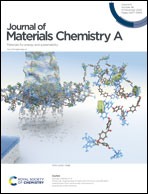Organic radical compound and carbon nanotube composites with enhanced electrical conductivity towards high-performance p-type and n-type thermoelectric materials†
Abstract
Small organic molecules are promising as the next generation of thermoelectric materials due to their unique advantages, such as low cost, high mechanical flexibility, low thermal conductivity, and low toxicity. However, their low electrical conductivities seriously limit the realization of high power factors. Herein, naphthalene diimide derivatives (NDI-1 and NDI-2) carrying a radical substituent of 2,2,6,6-tetramethyl-1-piperidinyloxyl (TEMPO) are designed and complexed with single-walled carbon nanotubes (SWCNTs) as both p-type and n-type thermoelectric composites. The introduction of the radical substituent remarkably improved the electrical conductivity by almost fifty percent compared to that of the NDI derivative without the radical substituent (NDI-0). The obtained radical-containing composites display greatly enhanced TE performance with highest power factors of 277.1 ± 5.4 μW m−1 K−2 for the p-type composite and 79.6 ± 1.7 μW m−1 K−2 for the n-type composite, respectively. Furthermore, the thermoelectric module based on NDI-1/SWCNT composite films consisting of five p–n junctions reaches a large output power of 2.81 μW under a 65 K temperature gradient. The enhanced electrical conductivities and TE performances of radical-containing NDI/SWCNT composite films are attributable to the improved doping level and charge transport process between the radical molecules and SWCNTs. This design strategy of introducing radical moieties into organic thermoelectric materials might be beneficial to the future application for high-performance p-type and n-type thermoelectric materials and devices.



 Please wait while we load your content...
Please wait while we load your content...